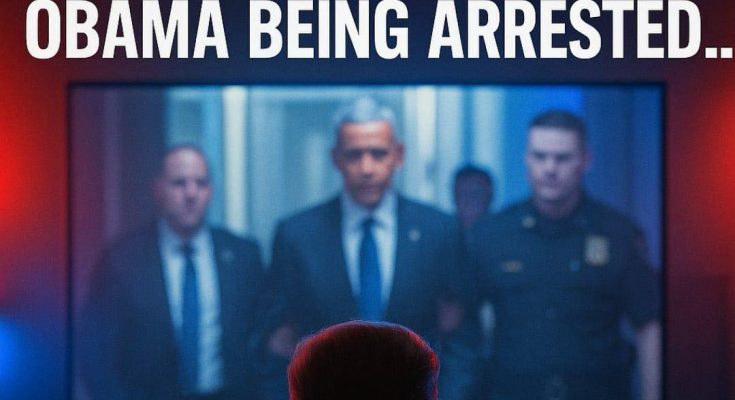In an age where artificial intelligence is blurring the lines between reality and fiction, former President Donald Trump has just ignited a digital firestorm. Over the weekend, Trump shared a hyper-realistic AI-generated video that appears to show former President Barack Obama being arrested—a move that has left millions of viewers stunned, outraged, and deeply confused.
The video, now viral across multiple social media platforms, is sparking heated debates across the political spectrum. Whether you see it as satire, a warning shot, or a reckless provocation, one thing is certain: this wasn’t posted by accident.
A Deepfake That Feels All Too Real
The video, crafted using advanced AI deepfake technology, shows what looks like Barack Obama being led away in handcuffs by law enforcement officers. The facial expressions, lighting, and even the audio seem eerily convincing—so much so that many viewers initially questioned whether it was real.
The clip doesn’t come with any caption from Trump himself. No context. No disclaimer. Just a surreal, explosive image uploaded to Truth Social and echoed by his loyal supporters.
Almost immediately, it began trending.
Is It Satire, or Something More Sinister?
Without a clear explanation from Trump, speculation has filled the void. Some commentators are calling the video “digital satire,” arguing that it’s a dramatization intended to provoke the media and stir conversation about political double standards. Others, however, see it as part of a more dangerous trend—using AI deepfakes to spread misinformation and fuel division.
But there’s also a third, more conspiratorial take gaining traction: that this video is a form of “predictive programming,” a concept popular among fringe theorists who believe public figures sometimes hint at future events through media.
Could Trump be signaling a coming storm?
Or is he simply trolling the establishment and baiting his critics, knowing the clip would spark a media frenzy?
The Dangers of Political Deepfakes
Whether you love or loathe Trump, the implications of this AI video are serious. AI-generated deepfakes, particularly when used in political messaging, carry the risk of confusing the public, inflaming partisan tensions, and undermining trust in real events.
Legal experts warn that without stricter regulations, we’re heading into a dangerous era where any image or video—no matter how outrageous—could be passed off as real. And with someone like Trump, who commands a massive and loyal online following, even the most absurd or fictional content can take on a life of its own.
“This is beyond trolling,” said one media ethics expert. “We’re talking about the weaponization of visual content.”
Why This Video Matters—Even If It’s Not Real
The release of this clip couldn’t come at a more chaotic time. With the 2024 election approaching and Trump once again dominating the Republican field, the political landscape is already on edge. Add in ongoing legal battles, a divided nation, and rapidly advancing AI tools—and you have the perfect storm for confusion, manipulation, and viral outrage.
The Obama arrest video isn’t just shocking. It’s a cultural moment, a preview of how deepfake media might dominate our political discourse going forward.
It also raises key questions:
Should platforms be required to label AI-generated political content?
Is this protected speech, or digital disinformation?
And most importantly: how do we, as voters and citizens, know what’s real anymore?
Trump’s History of Bold Media Gambits
This isn’t the first time Trump has shaken things up with unconventional messaging. Throughout his political career, he’s leaned heavily on viral content, controversial statements, and meme-driven media to rally his base and control the news cycle.
But this move is on a different level.
By posting a deepfake of a former president being arrested, Trump has crossed a new frontier—one where technology, truth, and theater collide in unpredictable ways.
And, as always, the internet is divided.
Reactions Across the Web
Reactions to the video have ranged from outrage to praise to complete disbelief.
“This is digital defamation. It’s dangerous,” wrote one user on X (formerly Twitter).
“He’s playing 4D chess again. This is a warning shot,” said another commenter on Truth Social.
“Satire or not, this is messed up,” added a YouTube content creator who analyzed the clip frame by frame.
Meanwhile, Obama himself has not responded to the video as of this writing.
The Future of Political Storytelling—Or Manipulation?
The rise of AI-generated content like this suggests we’re entering a new chapter in political messaging—one where fiction is mixed with reality to shape public perception.
Today it’s Obama in handcuffs. Tomorrow? It could be a video of Biden collapsing, or a foreign leader declaring war, all without a shred of truth behind it.
What happens when millions of people believe what they see—even if it’s manufactured?
What happens when powerful figures use deepfakes not just to entertain or provoke, but to reshape the narrative entirely?
A Blurred Line Between Truth and Theater
Trump’s decision to post an AI video of Obama’s fictional arrest may seem like another publicity stunt. But it could also be a chilling sign of what’s to come.
In a world flooded with content—some real, some fake—we’re all left asking: Who do we trust?
One thing’s for sure: This video will be talked about for a long time, not just for what it shows, but for what it means.
Stay alert. Stay skeptical. And always look twice before believing what you see online.



